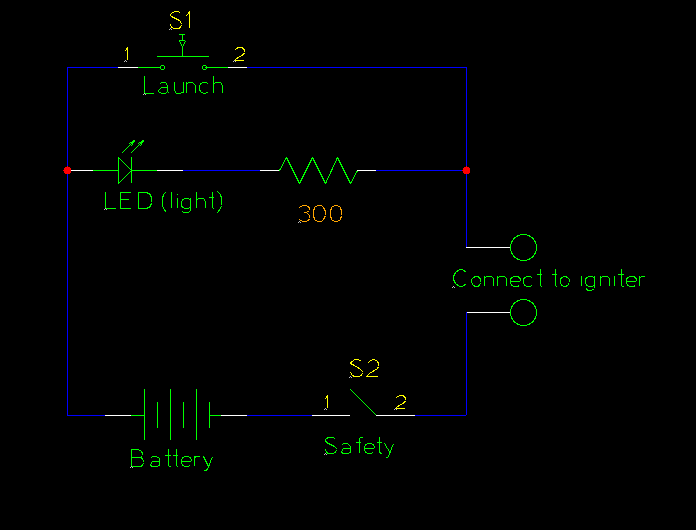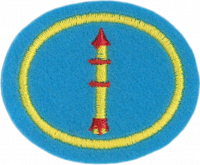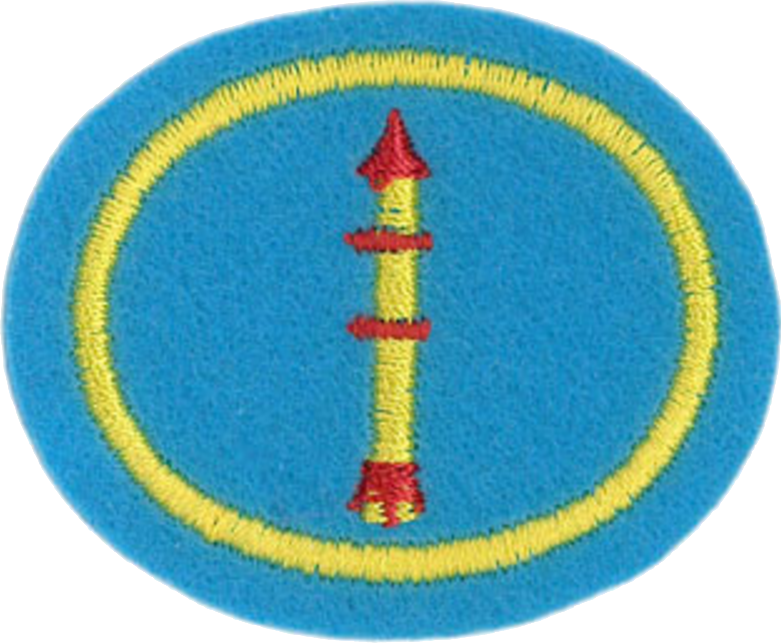Difference between revisions of "AY Honors/Model Rocketry/Answer Key/en"
(Updating to match new version of source page) |
(Updating to match new version of source page) |
||
| Line 1: | Line 1: | ||
{{HonorSubpage}} | {{HonorSubpage}} | ||
| − | <section begin="Body" /> | + | <section begin="Body" /> |
{{ansreq|page={{#titleparts:{{PAGENAME}}|2|1}}|num=1}} | {{ansreq|page={{#titleparts:{{PAGENAME}}|2|1}}|num=1}} | ||
<noinclude></noinclude> | <noinclude></noinclude> | ||
Latest revision as of 21:39, 1 January 2023
1
- Materials. I will use only lightweight, non-metal parts for the nose, body, and fins of my rocket.
- Motors. I will use only certified, commercially-made model rocket motors, and will not tamper with these motors or use them for any purposes except those recommended by the manufacturer.
- Ignition System. I will launch my rockets with an electrical launch system and electrical motor igniters. My launch system will have a safety interlock in series with the launch switch, and will use a launch switch that returns to the "off" position when released.
- Misfires. If my rocket does not launch when I press the button of my electrical launch system, I will remove the launcher's safety interlock or disconnect its battery, and will wait 60 seconds after the last launch attempt before allowing anyone to approach the rocket.
- Launch Safety. I will use a countdown before launch, and will ensure that everyone is paying attention and is a safe distance of at least 15 feet away when I launch rockets with D motors or smaller, and 30 feet when I launch larger rockets. If I am uncertain about the safety or stability of an untested rocket, I will check the stability before flight and will fly it only after warning spectators and clearing them away to a safe distance.
- Launcher. I will launch my rocket from a launch rod, tower, or rail that is pointed to within 30 degrees of the vertical to ensure that the rocket flies nearly straight up, and I will use a blast deflector to prevent the motor's exhaust from hitting the ground. To prevent accidental eye injury, I will place launchers so that the end of the launch rod is above eye level or will cap the end of the rod when it is not in use.
- Size. My model rocket will not weigh more than 1,500 grams (53 ounces) at liftoff and will not contain more than 125 grams (4.4 ounces) of propellant or 320 N-sec (71.9 pound-seconds) of total impulse. If my model rocket weighs more than one pound (453 grams) at liftoff or has more than four ounces (113 grams) of propellant, I will check and comply with Federal Aviation Administration regulations before flying.
- Flight Safety. I will not launch my rocket at targets, into clouds, or near airplanes, and will not put any flammable or explosive payload in my rocket.
- Launch Site. I will launch my rocket outdoors, in an open area at least as large as shown in the accompanying table, and in safe weather conditions with wind speeds no greater than 20 miles per hour. I will ensure that there is no dry grass close to the launch pad, and that the launch site does not present risk of grass fires.
- Recovery System. I will use a recovery system such as a streamer or parachute in my rocket so that it returns safely and undamaged and can be flown again, and I will use only flame-resistant or fireproof recovery system wadding in my rocket.
- Recovery Safety. I will not attempt to recover my rocket from power lines, tall trees, or other dangerous places.
2

The illustration above shows the parts of a single stage model rocket. We have laid the rocket on its side and cut a hole in the body tube so that we can see what is inside. Beginning at the far right, the body' of the rocket is a green cardboard tube with black fins attached at the rear. The fins can be made of either plastic or balsa wood and are used to provide stability during flight. Model rockets use small, pre-packaged, solid fuel engines. The engine is used only once, and then is replaced with a new engine for the next flight. Engines come in a variety of sizes and can be purchased at hobby stores and at some toy stores. The thrust of the engine is transmitted to the body of the rocket through the engine mount. This part is fixed to the rocket and can be made of heavy cardboard or wood. There is a hole through the engine mount to allow the ejection charge of the engine to pressurize the body tube at the end of the coasting phase and eject the nose cone and the recovery system. Recovery wadding is inserted between the engine mount and the recovery system to prevent the hot gas of the ejection charge from damaging the recovery system. The recovery wadding is sold with the engine. The recovery system consists of a parachute (or a streamer) and some lines to connect the parachute to the nose cone. Parachutes and streamers are made of thin sheets of plastic. The nose cone can be made of balsa wood, or plastic, and may be either solid or hollow. The nose cone is inserted into the body tube before flight. An elastic shock cord is connected to both the body tube and the nose cone and is used to keep all the parts of the rocket together during recovery. The launch lugs are small tubes (straws) which are attached to the body tube. The launch rail is inserted through these tubes to provide stability to the rocket during launch.
3
3a
- Launch: Launch begins as soon as the motor ignites and ends when the rocket clears the launch rail.
- Powered ascent: After the motor ignites, it generates thrust which causes the rocket to leave the launch pad and ascend into the air. The engine will continue to provide thrust for as long as it burns, and it will continue to power the rocket into the sky.
- Coasting flight: The motor will burn for a fixed amount of time and then stop. At this point, there is a delay and the rocket continues to glide upwards, riding the momentum gained during the thrust phase. As the engine burns through the delay charge, it leaves a trail of smoke as a visual aid to the rocketeer.
- Ejection Charge: At the end of the delay, the motor ignites an ejection charge which blows the nose cone off the rocket and deploys the recovery system.
- Slow descent: The rocket returns to the ground using one of the recovery techniques listed below.
- Recovery: When the rocket reaches the ground, it can usually be recovered by its owner.
3b
3c

In this launcher, power is supplied by a battery. When the safety switch is closed and the igniter is connected to the terminals (usually a pair of alligator clips), electricity flows from the battery, through the LED and resistor (lighting the LED), through the igniter, through the switch, and back into the battery completing the circuit. Because the current must flow through the LED and resistor, it is greatly reduced - not enough to sufficiently heat the igniter and start the rocket engine. The resistor in this circuit is 300 Ohms - high enough to keep the igniter from heating up, but low enough to light the LED.
As soon as the launch switch is closed, the electricity will flow through the switch instead of through the LED and resistor. Since the switch offers very low resistance to the current, the current is greatly increased. This increased current heats the igniter to a high enough temperature to start the rocket engine.
4
4a
Wadding is a fire-proof paper-like substance that is wadded up and place inside the body tube between the engine and the recovery system. Its purpose is to prevent the hot gases released by the engine from damaging the recovery system and payload. Wadding is sold as a package included with the engine.
4b
A boost glider is a model which is launched into the air via rocket power, and then all or part of it glides gently back to the earth using aerodynamic control surfaces. During the powered ascent, the glider portion acts as a stable, ballistic body attached to the rocket. It then transitions to a glider during the coasting flight phase. This transition presents the most challenging aspect of a boost glider design.
4c
In aerodynamics, a stall is a sudden reduction in the lift forces generated by an airfoil. This most usually occurs when the critical angle of attack for the airfoil is exceeded.
4d
The payload of a rocket is held in the nose cone. In model rocketry, there may or may not be a payload at all.
4e
A rocket's apogee is the highest point in its flight path.
4f
All matter, regardless of size, mass, or shape, has a point inside called the center of gravity, or more commonly, the center of mass (CM). The center of mass is the exact spot where all of the mass of that object is perfectly balanced. You can easily find the center of mass of an object such as a ruler by balancing the object on your finger. If the material used to make the ruler is of uniform thickness and density, the center of mass should be at the halfway point between one end of the stick and the other. If the ruler were made of wood, and a heavy nail were driven into one of its ends, the center of mass would no longer be in the middle. The balance point would then be nearer the end with the nail.
The center of mass is important in rocket flight because it is around this point that an unstable rocket tumbles. As a matter of fact, any object in flight tends to tumble. Throw a stick, and it tumbles end over end. Throw a ball, and it spins in flight. The act of spinning or tumbling is a way of becoming stabilized in flight. A Frisbee will go where you want it to only if you throw it with a deliberate spin. Try throwing a Frisbee without spinning it. If you succeed, you will see that the Frisbee flies in an erratic path and falls far short of its mark.
4g
In addition to center of mass, there is another important center inside the rocket that affects its flight. This is the center of pressure (CP). The center of pressure exists only when air is flowing past the moving rocket. This flowing air, rubbing and pushing against the outer surface of the rocket, can cause it to begin moving around one of its three axes. Think for a moment of a weather vane. A weather vane is an arrow-like stick that is mounted on a rooftop and used for telling wind direction. The arrow is attached to a vertical rod that acts as a pivot point. The arrow is balanced so that the center of mass is right at the pivot point. When the wind blows, the arrow turns, and the head of the arrow points into the on-coming wind. The tail of the arrow points in the downwind direction.
The reason that the weather vane arrow points into the wind is that the tail of the arrow has a much larger surface area than the arrowhead. The flowing air imparts a greater force to the tail than the head, and therefore the tail is pushed away. There is a point on the arrow where the surface area is the same on one side as the other. This spot is called the center of pressure. The center of pressure is not in the same place as the center of mass. If it were, then neither end of the arrow would be favored by the wind and the arrow would not point. The center of pressure is between the center of mass and the tail end of the arrow. This means that the tail end has more surface area than the head end.
It is extremely important that the center of pressure in a rocket be located toward the tail and the center of mass be located toward the nose. If they are in the same place or very near each other, then the rocket will be unstable in flight. The rocket will then try to rotate about the center of mass in the pitch and yaw axes, producing a dangerous situation. With the center of pressure located in the right place, the rocket will remain stable.
4h
An impulse may be regarded as the change in momentum of an object to which a force is applied.
4i
Velocity is a measurement of both speed and direction. If either speed or direction changes, the velocity changes.
4j
Ejection occurs at the end of the coasting phase of a model rocket's flight when the engine ignites the ejection charge. This charge blows the nose cone off and deploys a parachute or a streamer.
5
Nose Blow recovery
A very simple recovery technique, used in very early models in the 1950s and occasionally in modern examples, is nose-blow recovery. This is where the ejection charge of the motor ejects the nose cone of the rocket (usually attached by a shock cord made of rubber, Kevlar string or another type of cord) from the body tube, destroying the rocket's aerodynamic profile, causing highly-increased drag, and reducing the rocket's airspeed to a safe rate for landing. Nose-blow recovery is generally only suitable for very light rockets.
Tumble recovery
The simplest approach, and one only appropriate for small rockets or rockets with a large cross-sectional area, is to have the rocket tumble back to earth. Any rocket which will enter a stable, ballistic trajectory as it falls is not safe to use with tumble recovery.
Parachute/Streamer
The approach used most often in small model rockets. It uses the ejection charge of the motor (see below) to deploy, or push out, the parachute or streamer. Air resistance slows the rocket's fall, ending (hopefully) in a smooth, controlled and gentle landing.
Glide recovery
In glide recovery, the ejection charge either deploys an airfoil (wing) or separates a glider from the motor. If properly trimmed, the rocket/glider will enter a spiral glide and return safely. In some cases, radio-controlled rocket gliders are flown back to the earth by a pilot in much the way as R/C model airplanes are flown.
Some rockets (typically long thin rockets) are the proper proportions to safely glide to Earth tail-first. These are termed 'backsliders'.
Helicopter recovery
The ejection charge, through one of several methods, deploys helicopter-style blades and the rocket auto-rotates back to earth.
6
The National Association of Rocketry (NAR) has a wonderful guide for scouting and 4H organizations who wish to get into rocketry. You can get it here: http://www.nar.org/pdf/youthprogs.pdf
Model rockets are available at many hobby shops and toy stores.




